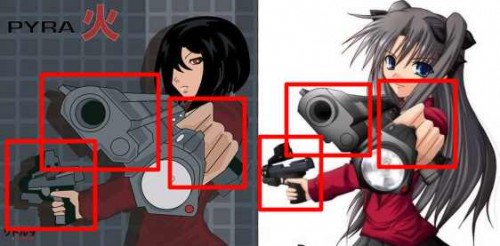The John Schiller Plagiarism Scandal
Though the Nick Simmons plagiarism scandal is probably the best known recent scandal in the manga community, another, very similar case has caused a stir of its own.
Jon Schiller Designs recently released a series of promotional drawings for its upcoming series SINS. However, an observant reader, who uses the name Sir Donuts, felt that he had seen much of the artwork before and, after some digging, posted on his personal blog comparing some of Schiller’s work to that of earlier mangas, in particular those by Capcom.
These allegations were then expanded upon by the site Bleeding Cool (Note: Some risqué content in link) and then began to circulate around the manga world.
Schiller responded to Bleeding Cool, first saying that the plagiarism was caused by an artist under the company’s employ and that it is being handled. However, Bleeding Cool later informed the company that it had reason to believe Schiller himself had plagiarized many of the designs, to which he responded, “…this is my style as many artist we get references & research from books toys and many others I did not copy anything that is very clear.”
However, Schiller’s site is currently down and images have disappeared from the company’s Flickr account. Given that these accusations were first filed almost two weeks ago, it seems that the Schiller is unlikely to return, at least not without some serious changes.
But did plagiarism actually occur? It only takes a cursory examination of the evidence to find out.
My Analysis
Sadly, you don’t really need to be an expert on plagiarism to see what clearly happened in this case. For example, take a look at the image below, focusing on the board the character is riding on.
There are simply too many identical details for it to be a coincidence. Look at the nose of the board, the vertical fin and the rocket for just a few examples. Schiller’s which is on the left, is a very clear trace and recolor of the original.
There are many other examples that show very similar levels of tracing, including a few I don’t feel comfortable showing on this site, but even some that appear at first to be more matters of inspiration or similar sourcing also show signs of clear tracing. For example, look at this comparison, once again with Schiller’s image on the left.
Though the characters are different, a look at the hand and the lining up of the fingers shows very clear signs of tracing and most of the details on the two guns, foreground and background, are also the same despite some differences.
There are other examples that are even more blatant but these two examples illustrate the idea. There are simply too many similarities, details and perfect matches to be coincidence and, since Schiller has never claimed it to be an homage, but rather his own style, it is difficult to make that argument as well.
In short, this case is pretty obvious and, where most of Nick Simmons allegations dealt with clear cases of “inspired by” (though clear traces came out later) this one deals mostly with traces, at least in large part.
All in all, this is why the images have disappeared from Flickr and why Jon Schiller’s site is down, either because he’s running from the accusations or has taken them down to fix the problem created bay an employee. Either way, the plagiarism is very real.
The Only Question
The only real question that remains is whether it was Schiller himself that did the plagiarism or someone under his employ. Though I would usually be very skeptical of unsupported claims that it was him, Schiller’s response seems to indicate that whatever evidence Bleeding Cool provided was authentic.
As such, it seems to me that most people are going to assume, with good reason, it was Schiller despite his earlier buck-passing. Unfortunately, based on the evidence I have in front of me, I have to agree.
Still, this is the one area we can not be sure of based on the evidence available and, given the nature of how design companies work, it may be impossible to be 100% sure.
Bottom Line
But even if it was Schiller’s associate who committed the plagiarism, Schiller himself, as the owner of the company and person whose name is on artwork, has to take responsibility. All that the issue at hand really determines is how much blame he should take.
The plagiarism is clear and, at some point, Schiller has to accept, at the very least, some of the blame for it.
The bigger question for me is why are these scandals becoming more common in the manga community? Could it be just random spike, similar to the Facebook RPG dramas of last year (Hammerfall and Castle Age) or is something more going on.
Part of it, I suspect, is that the manga fan base is so rabid and values originality so highly that they are likely to encounter plagiarism, recognize it and call it out. More than that though, though most manga fans have a favorite series, they routinely consume a wide variety of work in and take an interest in the whole of the genre, this increases the chances to spot and report on such cases.
In short, I don’t think the anime or manga industry is any more or less prone to plagiarism. Though competition is fierce, it seems more likely that a higher percentage of cases are being caught, not that there are more taking place.
That, in turn, is a big kudos to the fans of manga and their support for originality.
Want to Reuse or Republish this Content?
If you want to feature this article in your site, classroom or elsewhere, just let us know! We usually grant permission within 24 hours.



